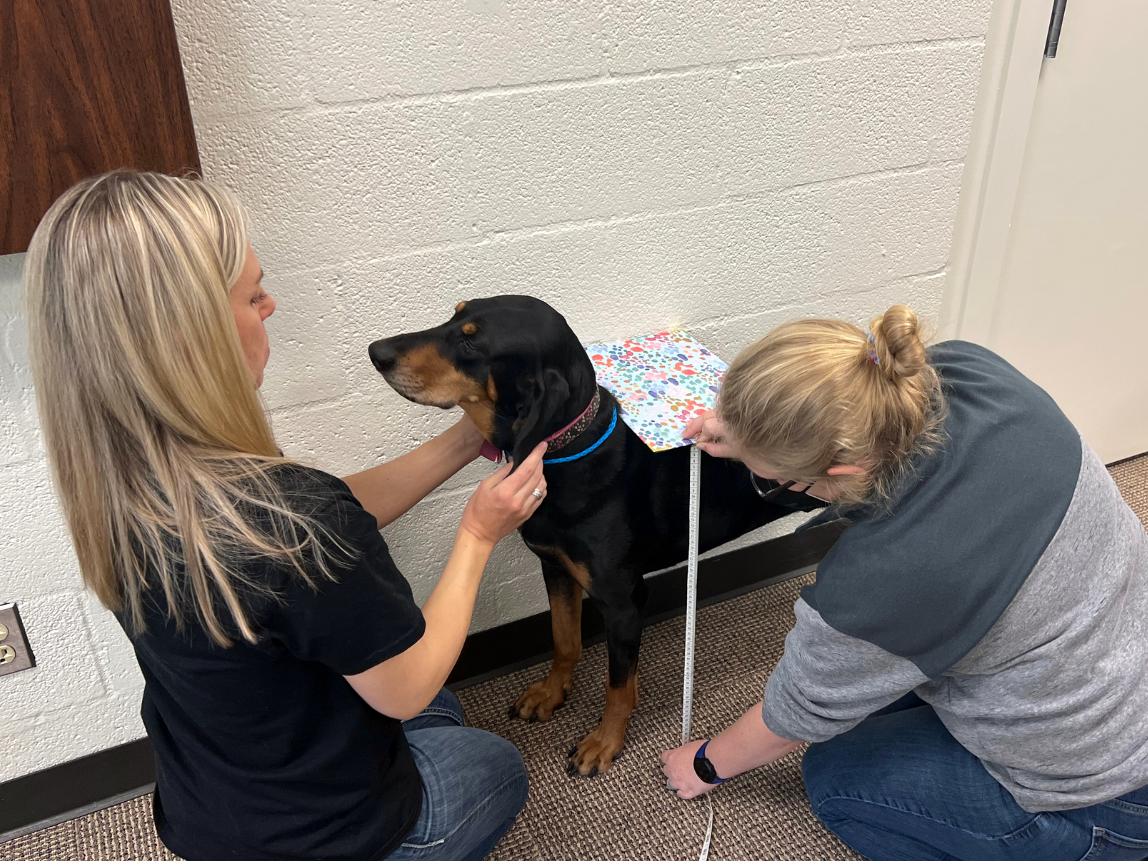Inside the Measurement & Mobility Activities
June 2, 2022 - 11 minutes readIt can be heartbreaking to watch your once agile pup grow old and slow down. Similar to people, as dogs age, they lose muscle mass and develop osteoarthritis that can make it difficult for them to be the athletes they once were. As they get older, your Labrador Retriever may struggle to get up or keep their footing on tile flooring or your Chihuahua may be less able to jump onto the couch. These are signs of decreased mobility in dogs and can occur as a dog gets older. The Measurement & Mobility Activities were designed by the Dog Aging Project to better understand these age-related changes.
What is osteoarthritis?
Osteoarthritis (OA) is the most common form of arthritis in dogs, affecting 20% of the canine population over the age of one and up to 80% of dogs older than eight years.[1] Although it can develop at any age, osteoarthritis is commonly considered a disease of aging. It is a chronic joint disease characterized by loss of joint cartilage, thickening of the joint capsule, and new bone formation around the joint (i.e. osteophytosis). This ultimately leads to pain and decreased mobility.
OA most often occurs in dogs that develop misalignment of their joints during growth (e.g. hip dysplasia, elbow dysplasia) or secondary to an injury (e.g. cranial cruciate ligament rupture aka ACL tear). For example, the normal hip joint is a ball-and-socket joint, where the ball of the femur typically rests comfortably in the pelvis. However some large breed dogs are genetically predisposed to the development of hip dysplasia. In hip dysplasia the ball and socket do not fit or develop properly. This leads to the bones rubbing and grinding together, promoting the loss of joint cartilage and new bone formation. These are the hallmark findings of OA.
Although OA has a strong genetic component, it can be exacerbated by aspects of lifestyle individual to each dog, including diet, body condition, and exercise levels. As a common cause of pain and decreased mobility in dogs, OA can affect a substantial portion of lifespan in dogs, as shown by studies that follow dogs over time (i.e. longitudinal studies).[2]
What causes muscle wasting?
The age-related loss of lean-body muscle mass is known as sarcopenia. This is different from the term cachexia, which describes the loss of muscle mass as the result of an underlying acute or chronic disease. Sarcopenia can be seen in a variety of species including people and companion animals such as dogs and cats. In people, sarcopenia begins early in life, starting around 30 years of age, with up to a 30% reduction in muscle mass noted during a person’s lifetime.[3]
Many things contribute to the development of muscle loss in dogs as they get older. This includes cellular changes related to aging, inflammatory cytokines, decreased nutrient absorption, decreased energy intake, metabolic diseases, and decreased physical activity. Given the discomfort that can occur with osteoarthritis, OA can also significantly contribute to muscle wasting in dogs as they age.
It makes sense that, without as much muscle, your tail-wagging companion may have less strength and struggle to jump into the car. However, loss of muscle has other negative effects including decreased immune function, wound healing, and survival.
How do we currently evaluate muscle mass in our dogs?
Most dogs that present to the veterinarian will have a body condition (BCS) evaluated. This number is reported on one of two scales (1-5 or 1-9) and is an evaluation of body fat. A dog that has a BCS of 1 is severely underweight, whereas a dog with a BCS of 9 is obese.
Although increased obesity can contribute to the development of osteoarthritis, a BCS does not tell us about a dog’s muscle mass. In fact, a dog that is aging tends to put on more body fat while losing muscle since they are not as physically active. Therefore, looking at BCS and changes in weight will often miss early muscle loss. Instead, your veterinarian may use a term known as a muscle condition score (MCS) to report a dog’s muscle mass.[4]
In a research setting, a body composition scan utilizing an x-ray technique (e.g. DEXA scan) may be utilized to look at the density of the body from which it can estimate the amount of lean muscle mass and fat tissue. Unfortunately, DEXA scans are not readily available and the MCS is not yet routinely utilized in veterinary medicine. Therefore, our current ability to monitor changes in a dog’s muscle mass over time is limited.
How is this being studied at the Dog Aging Project?
To help characterize the changes in mobility and body shape as dogs age, the Dog Aging Project recently launched the Measurement & Mobility Activities. This task has three parts:
- Measuring Your Dog
- Jog & Run Activity
- Stair Climb Activity
Measuring Your Dog
As you can tell by looking at the short, bowed legs of a Dachshund compared to the long legs of a Great Dane or the short face of a French Bulldog versus the long nose of a Borzoi, dogs are one of the most physically varied species on the planet. By taking measurements of specific parts of a dog’s body, we can better describe a dog’s shape and look at how these features may play a role in dog diseases and aging. In addition, part of this activity involves measuring thigh circumference, which can be helpful in monitoring a dog’s muscle mass, as many aging dogs lose muscle mass in their hind legs.
Jog & Run Activity
In order to assess a dog’s mobility, we ask participants to set up a 10-meter course (inside or outside) and then time their dog both jogging and running the course. This activity allows our veterinary team to evaluate a dog’s physical abilities at various gait speeds.
Stair Climb Activity
This activity provides our team with another way to assess a dog’s mobility. For dogs who are able to climb stairs safely, we ask participants to time their dog climbing a set of stairs. By comparing the performance of dogs from year to year, we will be able to better understand the physical decline that may occur during the aging process.
Who gets to participate in the Measurement & Mobility Activities??
We will be inviting all Dog Aging Project Pack members to complete the Measurement & Mobility Activities every year in April. More information on the Measurement & Mobility Activities can be found in our FAQs. If these activities aren’t a good fit for you or your dog, you can opt out of any or all of them in your personal research portal.
Old Dogs, Happy Dogs!
Even if they can’t run as far or fast as they used to, older dogs can still live rich and happy lives. For suggestions on helping your senior dog navigate the declining mobility that is often seen with aging, check out our blog post called Mobility Tips and Tricks for Senior Dogs. Here at the Dog Aging Project, we are committed to learning more about how our furry companions age so we can find interventions to help keep them comfortable and happy well into their senior years.
![]() 1. SA Johnston. 1997. Osteoarthritis: joint anatomy, physiology, and pathobiology. Veterinary Clinics of North America-Small Animal Practice 27:699–723. DOI: 10.1016/s0195-5616(97)50076-3
1. SA Johnston. 1997. Osteoarthritis: joint anatomy, physiology, and pathobiology. Veterinary Clinics of North America-Small Animal Practice 27:699–723. DOI: 10.1016/s0195-5616(97)50076-3
2 GK Smith et al. 2006. Lifelong diet restriction and radiographic evidence of osteoarthritis of the hip joint in dogs. Journal of American Veterinary Medical Association 229:690–693. DOI: 10.2460/javma.229.5.690
3 T Lang, T Streeper, P Cawthon et al. 2010. Sarcopenia: Etiology, Clinical Consequences, Intervention, and Assessment. Osteoporo Int. 21 (4):543-559. https://pubmed.ncbi.nlm.nih.gov/19779761/
4 MG Cline et al. 2021. AAHA Nutrition and Weight Management Guidelines for Dogs and Cats. J Am Anim Hosp Assoc. 57 (4):153-178. DOI: 10.5326/JAAHA-MS-7232

Dr. Sarah Schmid
Research Team
